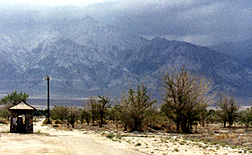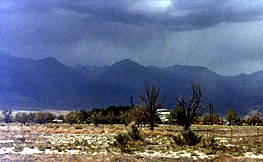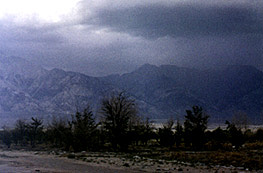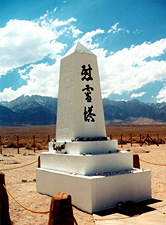|
Manzanar National Historic Site
 Part of my backpacking trip in 1977, was a stop at Manzanar. I had never heard of Manzanar before, so this was a new experience for me. To this day, I am amazed that our government did this to American citizens. At the time of my visit, Manzanar was a California State Historic Site. It is now a National Historic Site, established in 1992 and administered by the National Park Service. The plaque on one of the buildings at Manzanar reads as follows: Part of my backpacking trip in 1977, was a stop at Manzanar. I had never heard of Manzanar before, so this was a new experience for me. To this day, I am amazed that our government did this to American citizens. At the time of my visit, Manzanar was a California State Historic Site. It is now a National Historic Site, established in 1992 and administered by the National Park Service. The plaque on one of the buildings at Manzanar reads as follows:
"In the early parts of World War II, 10,000 persons of Japanese ancestry were interned in relocation centers by executive order No. 9066 issued on February 19, 1942.
Manzanar, the first of ten such concentration camps, was bounded by barbed wire and guard towers confining 10,000 persons, the majority being American Citizens.
May the injustices and humiliations suffered here as a result of hysterical rage and economic exploitation never emerge again"
 Many recent immigrants from Germany, Italy and Japan were treated as enemy aliens, but only the Japanese were treated harshly. Japanese bore the brunt of rage and hysteria following the bombing of Pearl Harbor on December 7, 1941. The United States Government relocated over 110,000 West Coast residents of Japanese ancestry to these camps. They lost their jobs, their businesses and their way of life and most were American citizens. More than half of all the people interned at Manzanar were women and children. The United States Government's official policy was the people were interned here and elsewhere for their own safety, yet all of the guard towers' guns were pointed inward, not outward. Many recent immigrants from Germany, Italy and Japan were treated as enemy aliens, but only the Japanese were treated harshly. Japanese bore the brunt of rage and hysteria following the bombing of Pearl Harbor on December 7, 1941. The United States Government relocated over 110,000 West Coast residents of Japanese ancestry to these camps. They lost their jobs, their businesses and their way of life and most were American citizens. More than half of all the people interned at Manzanar were women and children. The United States Government's official policy was the people were interned here and elsewhere for their own safety, yet all of the guard towers' guns were pointed inward, not outward.
Visiting Manzanar was a very haunting and eye opening experience, especially for a 19 year old student who thought he knew everything. I would like to go back again to walk around the camp and learn a little bit more about this dark period in our history. We stopped at the entrance to the camp to read the plaque and take a few pictures. There aren't any buildings left from the camp with the exception of the entry post and a large building that served as the  gymnasium and auditorium, which you can see in the middle picture. There are tours available, or you can walk the grounds yourself. As you can see from the pictures, the weather helped to create a sense of foreboding. It's a pretty desolate site backed up against the Eastern Sierra as it is. gymnasium and auditorium, which you can see in the middle picture. There are tours available, or you can walk the grounds yourself. As you can see from the pictures, the weather helped to create a sense of foreboding. It's a pretty desolate site backed up against the Eastern Sierra as it is.
There is now a self-driving tour through the compound with 27 different stops along the way. It allows you to get much close to some of the facilities than in the past. The gymnasium is still off limits, but there are plans in the near future to turn it into the visitors center for the site. Many of the old foundations have been excavated and you can see foundation slabs of some of the various buildings like the Manzanar Fire Department which is visible in the center of Block 13 near A Street. In fact, a 1942 Ford pumper, one of the originals engines at Manzanar, has been aquired and will be displayed in the future at the visitors center.
While taking this tour, we learned several things. In the late 1800's, the area was owned by John Shepherd who established a ranch on part of the site. In 1910, Shepherd's landholdings were purchased by George Chaffey who organized the town of Manzanar which existed from 1910 to 1925. The town was a ranching community and at its height had about 25 homes located within the boundaries.
Some of the occupants of Manzanar created elaborate gardens and there are plans to restore the water gardens to their former beauty. One garden is located in Block 34 and it was reported by the Block  Manager that "the men in our block are hard at work on building a fish pond and garden in front of the mess hall." It will be interesting to go back and see some of these restored gardens. There was a fairly extensive one located near the Manzanar hospital. Manager that "the men in our block are hard at work on building a fish pond and garden in front of the mess hall." It will be interesting to go back and see some of these restored gardens. There was a fairly extensive one located near the Manzanar hospital.
One haunting area that were able to view was the camp cemetary. The National Park Service erected a monument within the confines of the cemetary in 1995. There were also several new headstones. All around the monument were small offerings like trinkets, beads, strings of paper cranes, small tennis shoes, etc. The only thing that I can compare this to would be the Vietnam War Memorial. There were inscriptions on two sides of the memorial tower. The inscriptions on the west side of the tower reads "August 1943" and "for the people of Manzanar." On the other side, which is shown in the picture, the inscription reads, "Monument to console the souls of the dead."
If you are interested in visiting Manzanar, take HWY 395 in Eastern California. Manzanar is located about 5 miles south of Independence and about 12 miles north of Lone Pine. There is also a museum located in Independence, California. Hours at the facility are basically daylight hours and there is no fee for admission at this time.
Next national park site.
Back to the National Park Page
This backpacking trip also included stops at Devils Postpile and the High Sierra.
 |

 Part of my backpacking trip in 1977, was a stop at Manzanar. I had never heard of Manzanar before, so this was a new experience for me. To this day, I am amazed that our government did this to American citizens. At the time of my visit, Manzanar was a California State Historic Site. It is now a National Historic Site, established in 1992 and administered by the National Park Service. The plaque on one of the buildings at Manzanar reads as follows:
Part of my backpacking trip in 1977, was a stop at Manzanar. I had never heard of Manzanar before, so this was a new experience for me. To this day, I am amazed that our government did this to American citizens. At the time of my visit, Manzanar was a California State Historic Site. It is now a National Historic Site, established in 1992 and administered by the National Park Service. The plaque on one of the buildings at Manzanar reads as follows: Many recent immigrants from Germany, Italy and Japan were treated as enemy aliens, but only the Japanese were treated harshly. Japanese bore the brunt of rage and hysteria following the bombing of Pearl Harbor on December 7, 1941. The United States Government relocated over 110,000 West Coast residents of Japanese ancestry to these camps. They lost their jobs, their businesses and their way of life and most were American citizens. More than half of all the people interned at Manzanar were women and children. The United States Government's official policy was the people were interned here and elsewhere for their own safety, yet all of the guard towers' guns were pointed inward, not outward.
Many recent immigrants from Germany, Italy and Japan were treated as enemy aliens, but only the Japanese were treated harshly. Japanese bore the brunt of rage and hysteria following the bombing of Pearl Harbor on December 7, 1941. The United States Government relocated over 110,000 West Coast residents of Japanese ancestry to these camps. They lost their jobs, their businesses and their way of life and most were American citizens. More than half of all the people interned at Manzanar were women and children. The United States Government's official policy was the people were interned here and elsewhere for their own safety, yet all of the guard towers' guns were pointed inward, not outward. gymnasium and auditorium, which you can see in the middle picture. There are tours available, or you can walk the grounds yourself. As you can see from the pictures, the weather helped to create a sense of foreboding. It's a pretty desolate site backed up against the Eastern Sierra as it is.
gymnasium and auditorium, which you can see in the middle picture. There are tours available, or you can walk the grounds yourself. As you can see from the pictures, the weather helped to create a sense of foreboding. It's a pretty desolate site backed up against the Eastern Sierra as it is. Manager that "the men in our block are hard at work on building a fish pond and garden in front of the mess hall." It will be interesting to go back and see some of these restored gardens. There was a fairly extensive one located near the Manzanar hospital.
Manager that "the men in our block are hard at work on building a fish pond and garden in front of the mess hall." It will be interesting to go back and see some of these restored gardens. There was a fairly extensive one located near the Manzanar hospital.